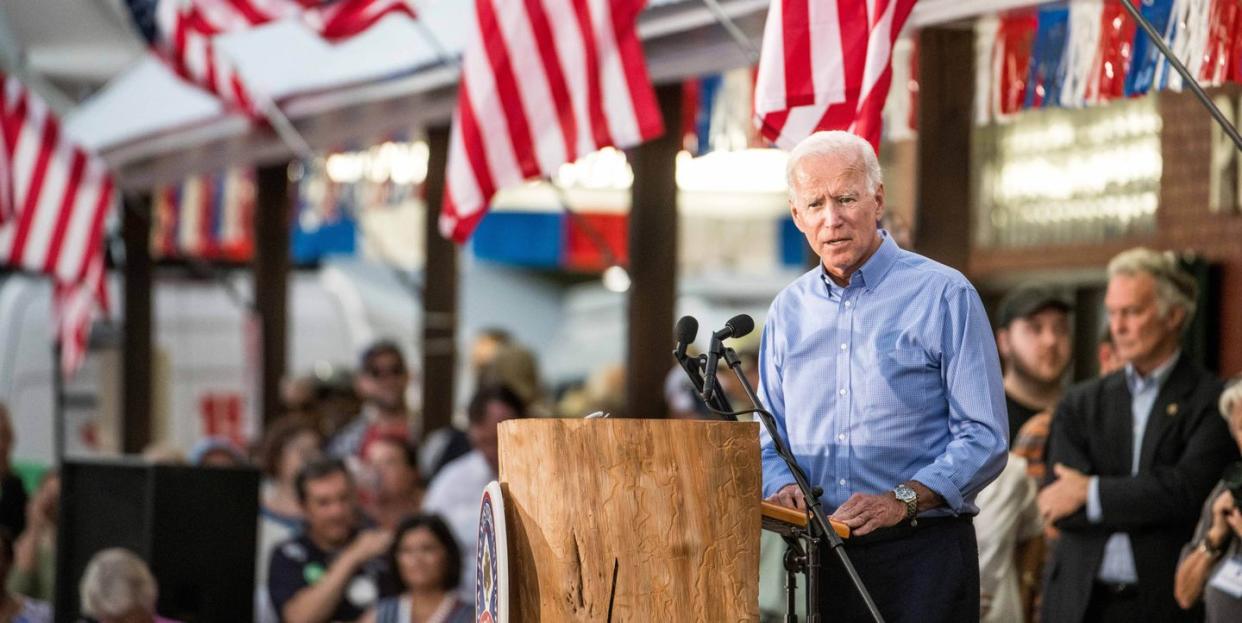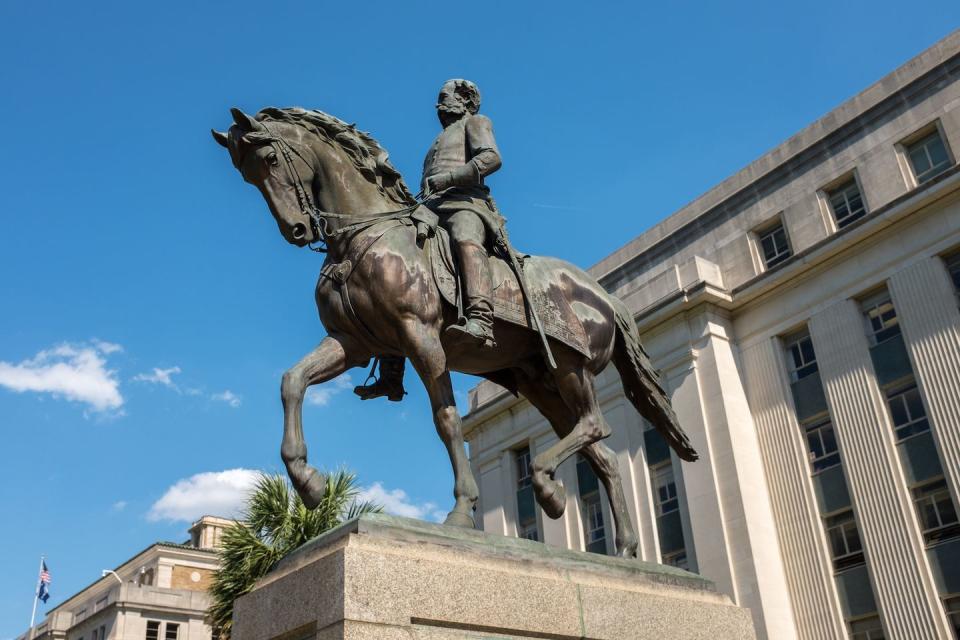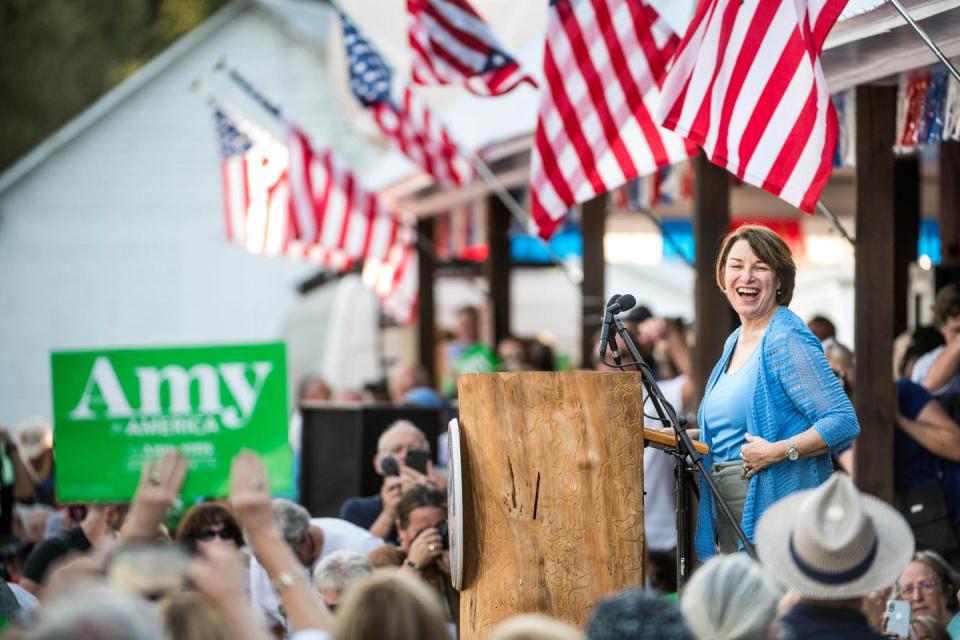Joe Biden Was Born for the Galivants Ferry Stump

GALLIVANTS FERRY, SOUTH CAROLINA—The elections of 1876 in the state of South Carolina are a fair choice to be selected as the worst elections in the history of the republic. They took place during a fraught time in the country generally. The forces of white supremacy—the "Redeemers"—began to sense that the national commitment to the project of Reconstruction, and especially the national commitment to equal rights for the newly freed African-American citizens, was beginning to flag. Moral exhaustion was setting in all over the north, and especially in the halls of the national government.
The states formerly in rebellion against the United States were still occupied by federal troops. Under their protection, and empowered by the Reconstruction Amendments, African Americans had been elected to state legislatures and to the Congress. All of them were Republicans, members of the party of Abraham Lincoln, who had fought the war that had made them free. But the power of white supremacy was rising. Armed white insurgents were roaming the countryside, Some 20,000 men joined so-called "rifle clubs," which actually functioned as paramilitary units. The "Red Shirts," a more formal paramilitary organization, arose in the mid-1870s. Their political vehicle was the Democratic Party. In 1876, both the party and the insurgency were ready to make their move.
The Democratic candidate was Wade Hampton III, a former Confederate cavalry general and, before the war, the scion of one of the largest slaveholding families in the entire South. His opponent, incumbent Republican Daniel Chamberlain, had fought for the Union and had been elected largely through the state's newly enfranchised African American voters.

Violence and bloodshed were in the air. In July of 1876, in the small town of Hamburg, the members of an African-American militia, formed for the purposes of self-defense against the burgeoning vigilante movement, exchanged fire with the members of several local rifle clubs. When the militia men took shelter in an armory, the white paramilitaries brought down a cannon and blew out the armory's wall. The surviving militiamen were slaughtered in the streets. From his election headquarters in a Charleston brothel, Hampton, who met regularly with the Red Shirts there, told his supporters that the events in Hamburg proved that the Reconstruction project had ignited a race war.
The entire election process was shredded with white-supremacist violence, right up until election day and even afterwards. In Edgefield, armed whites on horseback blockaded the polling place. Poll sites in Abbeville County and elsewhere were attacked. Vigilantes in Barnwell opened fire on a polling place and stole the ballot box. The ratfcking took other, less violent forms: local Democratic officials, taking advantage of illiterate black voters, handed them ballots with which they inadvertently were tricked into voting for Democratic candidates. And despite all of this, Hampton only won the election by a little more than 1,100 votes, aided immeasurably by the tallies in two counties in which more people were recorded as having voted than actually lived there.
The aftermath was chaos. Hampton was locked out of the state capitol. Inside the capitol, the legislature, a Republican state senate and a Democratic house were on the verge of explosion. Only U.S. Army troops kept the two sides from tearing each other apart. However, in Washington, a commission had been assembled to sort out the contentious presidential election between Republican Rutherford Hayes and Democrat William Tilden. (Obviously, South Carolina's electoral votes were critical there and, because the state balloting had been such a fiasco, the state had sent two slates of electors to Washington.) The notorious deal that was finally cut allowed Hayes to be president, but the price was the withdrawal of federal troops from the South and the de facto end of Reconstruction.
When the soldiers left, Wade Hampton was installed as governor. Chamberlain, who left the state, did so with a remarkably prescient remark:
The government of the United States abandons you, deliberately withdraws from you its support, with full knowledge that the lawful Government of the State will be speedily overthrown ... forsaking the lawful State Government to a struggle with insurrectionary forces too powerful to be resisted.
On September 30, 1876, when the awful election was in full cry, Wade Hampton stopped by the small upcountry town of Galivants Ferry to speak to a gathering of Horry County Democrats. A local shopkeeper and entrepreneur named Joseph Holliday offered a pine thicket across from his store as a venue for electioneering. Over the next century, what became known as the Galivants Ferry Stump became a mandatory stop for anyone who was running in Democratic primary elections in South Carolina. On Monday, for the first time ever, a special Galivants Stump was held specifically for the purpose of bringing Democratic presidential candidates to town.

Eleanor Welling, a retired schoolteacher from Greenville and a Democrat "from my mother's milk," took a rocking chair on the porch of the store, now run by the fourth generation of Hollidays. She'd come out early to help set up the chairs for the Stump. She'd been wearing a baseball cap then. But now, with the work done, she'd swapped out the ballcap for a broad-brimmed white summer hat. Ms. Welling took in the scene—a sweep across the parking lot that included tents for various candidates and activist groups, a soul food stand, the inevitable boiled peanuts vendor, and a very different South Carolina from any South Carolina that Wade Hampton would have recognized.
"I became a Democrat because it became the civil-rights party," she said. "It was around my high school era, when Strom Thurmond was leaving the Democratic Party to become a Republican. It's been a continuing battle. I had a father who thought there were going to be a continuing race war, with people leaving the Democratic Party. The Democratic Party was leaving him, is the way he put it.
"I had a mother, thank God, who was a deeply religious, devout person, who explained it to me that we used to own slaves in our family, and I wept to hear it, and she made it a point to tell me to stay on the side of justice."
It is a popular right-wing trope to point out that the Republican Party freed the slaves and that the Democratic Party was the party of white supremacy. This was true back in Wade Hampton's day, but, as Eleanor Welling's father's ideological journey proved, and as hundreds of political historians endlessly argue in the classroom and on social media, a political diaspora occurred in the 1960s, when the Democrats allied themselves with the Civil Rights Movement and the Republicans determined to attach themselves with the remnants of American apartheid. "South Carolina," said Jimmy Williams, one of the Stump's organizers and a political consultant who worked for Senator Dick Durbin, "looks like America, thank God."
Four presidential candidates came to the extra-special Galivants Ferry Stump on Monday: Amy Klobuchar, Bill deBlasio, Pete Buttigieg, and Joe Biden. Klobuchar continued to present herself as a sensible voice for the political middle, leaning hard into the midwest folksy demeanor. (Pro Tip: Jokes work better if you don't preface them with, "Here's a joke about that.") Buttigieg got off the best line of the evening. Speaking about the president's preferred mode of communication, Buttigieg, a former combat soldier, explained, "I've faced worse incoming than a tweet full of typos."
However, this was an old-school political event, and old-school political events are what Joe Biden was born for. He turned on his 100-watt smile, and he told some first-hand stories about former Senator Fritz Hollings, the patron saint of modern South Carolina Democrats. (By contrast, Klobuchar told a story that the late Paul Wellstone had told her about Wellstone's first encounter with Hollings.) And, from behind the rostrum, you could see the smiles and the nods spread over the crowd like sunrise over the sea. This was a crowd that wanted a Democrat to win who could re-establish some kind of familiar politics after four years of having the republic subject to the whims and deceits of a vulgar talking yam. If you want to see the source of strength behind Biden's campaign, it was in those smiles and nods through which the crowd seemed to exhale as one.

Biden's pitch continued to be a return to political normalcy. He again recited a litany of the victims of white-supremacist violence from the Birmingham church bombing to the present day, and he hung the president*'s rhetoric on that strand of bloody American history. "We all know who Donald Trump is," Biden said. "Even the people who support him know who he is. But here's the deal. We've got to let him know who we are. We stand for hope over fear. We stand for unity over division. We stand for truth over lies. We stand for science over fiction. Look, folks, we're better prepared to lead the world than any nation in the world."
It was an old-school event in which, if you looked at it from the right angle, you could see the entire sweep of American political history from Appomattox to the present day—all the stubborn anger and hate and all the equally stubborn movement forward toward something resembling a fulfillment of the country's founding promises.
"It's amazing because you see the entire political evolution of the South," said Jamie Harrison, a young veteran African-American activist who currently is engaged in God's own work of trying to excise Lindsey Graham from the Senate. "Like I say, when you understand history, you can make history. When this thing started, the idea of somebody like me up there speaking on that stump?"
When Harrison finished speaking to the gathering, he was enfolded in an embrace by State Senator John Land, a big, white-haired Caucasian in a big straw hat, a guy with a voice that sounds like a tolling bell that, unaided, might have reached deep into the pecan groves beyond. And across the state, down in Charleston, in the burial ground of the Trinity Episcopal Cathedral, former Governor Wade Hampton III probably commenced to revolve at 78 rpm.
"Good," said Jamie Harrison. "I hope he's spinning."
Respond to this post on the Esquire Politics Facebook page here.
You Might Also Like

